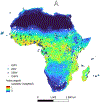Technical validation of a multiplex real-time PCR for combined detection of Rift Valley fever, chikungunya, Zika and dengue viruses
- PMID: 40345597
- PMCID: PMC12328903
- DOI: 10.1016/j.jviromet.2025.115174
Technical validation of a multiplex real-time PCR for combined detection of Rift Valley fever, chikungunya, Zika and dengue viruses
Abstract
Several arthropod-borne (arbo)-viruses have overlapping symptoms, insect vectors and geographical occurrence. With little known about the importance of arboviruses as cause of acute undifferentiated fever (AUF) in East and Central Africa (ECA), there is a clear need for a multiplex-PCR allowing for multi-pathogen surveillance. A multiplex real-time RT-PCR (RDCZ-multiplex) was developed and validated for the simultaneous detection of Rift Valley fever virus (RVFV), dengue virus 1-4 (DENV), chikungunya virus (CHIKV) and Zika virus (ZIKV). Phocine distemper virus (PDV) was added to the PCR as sample extraction control. Validation was conducted following the MIQE-guidelines using a panel of retrospective clinical samples and Quality Control for Molecular Diagnostics (QCMD, https://www.qcmd.org/en/) samples with the simplex-PCR as reference. These included samples from RVFV in animals (n = 19), DENV (n = 15), CHIKV (n = 11), ZIKV (n = 2) and YFV (n = 1, QCMD), and 14 negative endemic controls. Extractions and PCRs were done with commercially available kits. Some loss of sensitivity was observed at low target concentrations for RVFV, DENV1 and DENV4, when comparing the standard curves of simplex-PCRs with the multiplex-PCR. The limit of detection of the multiplex-PCR was 2064 copies/ml for CHIKV, 3587 copies/ml for DENV1, 30,249 copies/ml for ZIKV and 73 PFU/ml for RVFV. Specificity of the multiplex-PCRs was 100 %. For 12 out of 48 positive samples with high Cq values, RVFV (n = 7), CHIKV (n = 2), DENV1 (n = 2), YFV (n = 1), the multiplex-PCRs were negative. Although PCR sensitivity of the RDCZ-multiplex is slightly lower with low target concentrations, it offers a useful tool for molecular surveillance and clinical diagnosis for arboviruses for the ECA-region.
Keywords: Arbovirus; Chikungunya virus; Dengue virus; Real-time multiplex RT-PCR; Rift valley fever virus; Validation; Zika virus.
Copyright © 2025 The Authors. Published by Elsevier B.V. All rights reserved.
Conflict of interest statement
Declaration of Competing Interest The authors declare that they have no known competing financial interests or personal relationships that could have appeared to influence the work reported in this paper.
Figures


References
Publication types
MeSH terms
Grants and funding
LinkOut - more resources
Full Text Sources
Research Materials

